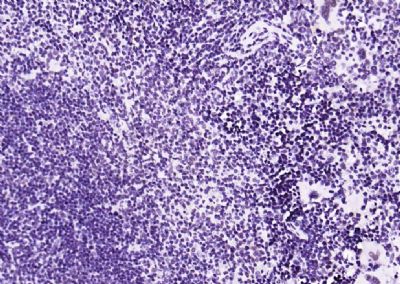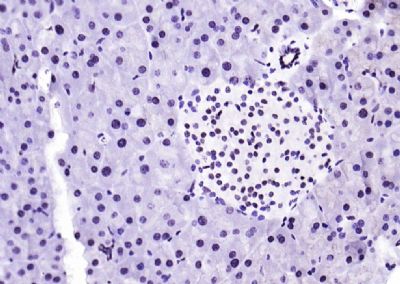
磷酸化信号转导与转录激活因子1抗体
基本信息

产品名称:
磷酸化信号转导与转录激活因子1抗体
英文名称:
phospho-STAT1 (Ser727)
国产/进口:
国产
产地/品牌:
雅吉生物
型号:
52209R
参考报价:
销售商:
总点击数:
584
更新日期:
2025-10-27
产品类别:
性能参数

英文名称phospho-STAT1 (Ser727)
中文名称磷酸化信号转导与转录激活因子1重组兔单克隆抗体
别 名STAT1(S727); STAT1 (phospho S727); p-STAT1 (phospho S727); STAT1(Phospho-Ser727); signal transducers and activators of transcription 1; DKFZp686B04100; ISGF 3; ISGF-3; Signal transducer and activator of transcription 1 91kDa; Signal transducer and activator of transcription 1 alpha/beta; STAT 1; STAT-1; STAT 91; STAT91; Transcription factor ISGF 3 components p91 p84; ; Transcription factor ISGF-3 components p91/p84; OTTHUMP00000163552; OTTHUMP00000165046; OTTHUMP00000165047; OTTHUMP00000205845; Signal transducer and activator of transcription 1, 91kD; Signal transducer and activator of transcription 1-alpha/beta; Signal Transductor and Activator of Transcription 1; STAT1_HUMAN; CANDF7; IMD31A; IMD31B; IMD31C.
产品类型磷酸化抗体
研究领域肿瘤 细胞生物 免疫学 信号转导 细胞凋亡 转录调节因子 激酶和磷酸酶
抗体来源Rabbit
克隆类型Monoclonal
克 隆 号8A1
交叉反应Human, Mouse, Rat,
产品应用WB=1:500-1000 IHC-P=1:50-200 (石蜡切片需做抗原修复)
not yet tested in other applications.
optimal dilutions/concentrations should be determined by the end user.
分 子 量87kDa
细胞定位细胞核 细胞浆
性 状Liquid
浓 度1mg/ml
免 疫 原KLH conjugated Synthesised phosphopeptide derived from human STAT1 around the phosphorylation site of Ser727:PM(p-S)PE
亚 型IgG
纯化方法affinity purified by Protein A
储 存 液0.01M TBS(pH7.4) with 1% BSA, 0.03% Proclin300 and 50% Glycerol.
保存条件Shipped at 4℃. Store at -20 °C for one year. Avoid repeated freeze/thaw cycles.
PubMedPubMed
产品介绍The protein encoded by this gene is a member of the STAT protein family. In response to cytokines and growth factors, STAT family members are phosphorylated by the receptor associated kinases, and then form homo- or heterodimers that translocate to the cell nucleus where they act as transcription activators. This protein can be activated by various ligands including interferon-alpha, interferon-gamma, EGF, PDGF and IL6. This protein mediates the expression of a variety of genes, which is thought to be important for cell viability in response to different cell stimuli and pathogens. Two alternatively spliced transcript variants encoding distinct isoforms have been described.
Function:
Signal transducer and transcription activator that mediates cellular responses to interferons (IFNs), cytokine KITLG/SCF and other cytokines and growth factors. Following type I IFN (IFN-alpha and IFN-beta) binding to cell surface receptors, signaling via protein kinases leads to activation of Jak kinases (TYK2 and JAK1) and to tyrosine phosphorylation of STAT1 and STAT2. The phosphorylated STATs dimerize, associate with ISGF3G/IRF-9 to form a complex termed ISGF3 transcription factor, that enters the nucleus. ISGF3 binds to the IFN stimulated response element (ISRE) to activate the transcription of interferon stimulated genes, which drive the cell in an antiviral state. In response to type II IFN (IFN-gamma), STAT1 is tyrosine-and serine-phosphorylated. It then forms a homodimer termed IFN-gamma-activated factor (GAF), migrates into the nucleus and binds to the IFN gamma activated sequence (GAS) to drive the expression of the target genes, inducing a cellular antiviral state. Becomes activated in response to KITLG/SCF and KIT signaling. May mediate cellular responses to activated FGFR1, FGFR2, FGFR3 and FGFR4.
Subunit:
Isoform alpha homodimerizes upon IFN-gamma induced phosphorylation. Heterodimer with STAT2 upon IFN-alpha/beta induced phosphorylation. Interacts with NMI. Interacts with Sendai virus C', C, Y1 and Y2 proteins, Nipah virus P, V and W proteins, and rabies virus phosphoprotein preventing activation of ISRE and GAS promoter (By similarity). Interacts with HCV core protein; the interaction results in STAT1 degradation. Interacts with PIAS1; the interaction requires phosphorylation on Ser-727 and inhibits STAT1 activation. Interacts with IFNAR1; the interaction requires the phosphorylation of IFNAR1 at 'Tyr-466'. Interacts with IFNAR2. Interacts with PIAS1 (dimethylated on arginine); the interaction results in release of STAT1 from its target gene. Interacts with SRC. Interacts with ERBB4 (phosphorylated). Interacts with PTK2/FAK1.
Subcellular Location:
Cytoplasm. Nucleus. Note=Translocated into the nucleus upon tyrosine phosphorylation and dimerization, in response to IFN-gamma and signaling by activated FGFR1, FGFR2, FGFR3 or FGFR4.
Post-translational modifications:
Phosphorylated on tyrosine and serine residues in response to a variety of cytokines/growth hormones including IFN-alpha, IFN-gamma, PDGF and EGF. Activated KIT promotes phosphorylation on tyrosine residues and subsequent translocation to the nucleus. Tyrosine phosphorylated in response to constitutively activated FGFR1, FGFR2, FGFR3 and FGFR4. Upon EGF stimulation, phosphorylation on Tyr-701 (lacking in beta form) by JAK1, JAK2 or TYK2 promotes dimerization and subsequent translocation to the nucleus. Growth hormone (GH) activates STAT1 signaling only via JAK2. PHosphorylation on Ser-727 by several kinases including MAPK14, ERK1/2 and CAMKII on IFN-gamma stimulation, regulates STAT1 transcriptional activity. Phosphorylation on Ser-727 promotes sumoylation though increasing interaction with PIAS. Phosphorylation on Ser-727 by PKCdelta induces apoptosis in response to DNA-damaging agents. Phosphorylated on tyrosine residues when PTK2/FAK1 is activated; most likely this is catalyzed by a SRC family kinase.
Sumoylated by SUMO1, SUMO2 and SUMO3. Sumoylation is enhanced by IFN-gamma-induced phosphorylation on Ser-727, and by interaction with PIAS proteins. Enhances the transactivation activity.
ISGylated.
DISEASE:
Defects in STAT1 are the cause of STAT1 deficiency complete (STAT1D) [MIM:613796]. STAT1D is a disorder characterized by susceptibility to severe mycobacterial and viral infections. Affected individuals can develop disseminated infections and die of viral illness.
Defects in STAT1 are a cause of mendelian susceptibility to mycobacterial disease (MSMD) [MIM:209950]; also known as familial disseminated atypical mycobacterial infection. This rare condition confers predisposition to illness caused by moderately virulent mycobacterial species, such as Bacillus Calmette-Guerin (BCG) vaccine and environmental non-tuberculous mycobacteria, and by the more virulent Mycobacterium tuberculosis. Other microorganisms rarely cause severe clinical disease in individuals with susceptibility to mycobacterial infections, with the exception of Salmonella which infects less than 50% of these individuals. The pathogenic mechanism underlying MSMD is the impairment of interferon-gamma mediated immunity whose severity determines the clinical outcome. Some patients die of overwhelming mycobacterial disease with lepromatous-like lesions in early childhood, whereas others develop, later in life, disseminated but curable infections with tuberculoid granulomas. MSMD is a genetically heterogeneous disease with autosomal recessive, autosomal dominant or X-linked inheritance.
Defects in STAT1 are the cause of familial candidiasis type 7 (CANDF7) [MIM:614162]. A primary immunodeficiency disorder with altered immune responses and impaired clearance of fungal infections, selective against Candida. It is characterized by persistent and/or recurrent infections of the skin, nails and mucous membranes caused by organisms of the genus Candida, mainly Candida albicans. Note=STAT1 mutations in patients with autosomal dominant candidiasis lead to defective responses of type 1 and type 17 helper T-cells, characterized by reduced production of interferon-alpha, interleukin-17, and interleukin-22. These cytokines are crucial for the antifungal defense of skin and mucosa (PubMed:21714643).
Similarity:
Belongs to the transcription factor STAT family.
Contains 1 SH2 domain.
SWISS:
P42224
Gene ID:
6772
Database links:
Entrez Gene: 6772 Human
Entrez Gene: 20846 Mouse
Entrez Gene: 25124 Rat
Omim: 600555 Human
SwissProt: P42224 Human
SwissProt: P42225 Mouse
Unigene: 642990 Human
Unigene: 277406 Mouse
Unigene: 33229 Rat
Important Note:
This product as supplied is intended for research use only, not for use in human, therapeutic or diagnostic applications.
| 产品图片 |
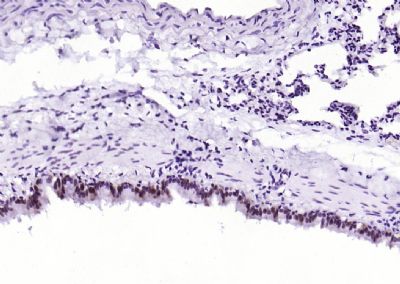 Paraformaldehyde-fixed, paraffin embedded (rat lung); Antigen retrieval by boiling in sodium citrate buffer (pH6.0) for 15min; Block endogenous peroxidase by 3% hydrogen peroxide for 20 minutes; Blocking buffer (normal goat serum) at 37°C for 30min; Antibody incubation with (phospho-STAT1 (Ser727)) Monoclonal Antibody, Unconjugated (bsm-52209R) at 1:200 overnight at 4°C, followed by operating according to SP Kit(Rabbit) (sp-0023) instructionsand DAB staining.
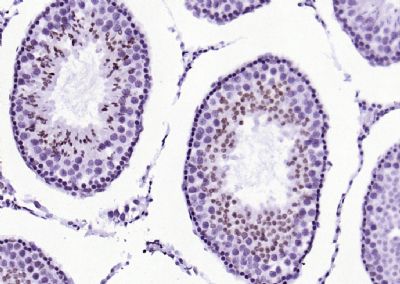 Paraformaldehyde-fixed, paraffin embedded (rat testis); Antigen retrieval by boiling in sodium citrate buffer (pH6.0) for 15min; Block endogenous peroxidase by 3% hydrogen peroxide for 20 minutes; Blocking buffer (normal goat serum) at 37°C for 30min; Antibody incubation with (phospho-STAT1 (Ser727)) Monoclonal Antibody, Unconjugated (bsm-52209R) at 1:200 overnight at 4°C, followed by operating according to SP Kit(Rabbit) (sp-0023) instructionsand DAB staining.
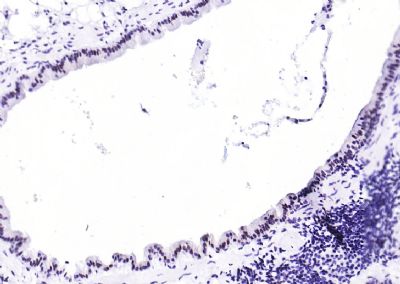 Paraformaldehyde-fixed, paraffin embedded (mouse lung); Antigen retrieval by boiling in sodium citrate buffer (pH6.0) for 15min; Block endogenous peroxidase by 3% hydrogen peroxide for 20 minutes; Blocking buffer (normal goat serum) at 37°C for 30min; Antibody incubation with (phospho-STAT1 (Ser727)) Monoclonal Antibody, Unconjugated (bsm-52209R) at 1:200 overnight at 4°C, followed by operating according to SP Kit(Rabbit) (sp-0023) instructionsand DAB staining.
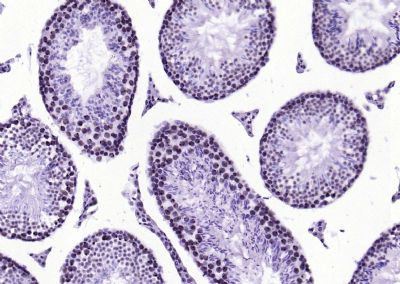 Paraformaldehyde-fixed, paraffin embedded (mouse testis); Antigen retrieval by boiling in sodium citrate buffer (pH6.0) for 15min; Block endogenous peroxidase by 3% hydrogen peroxide for 20 minutes; Blocking buffer (normal goat serum) at 37°C for 30min; Antibody incubation with (phospho-STAT1 (Ser727)) Monoclonal Antibody, Unconjugated (bsm-52209R) at 1:200 overnight at 4°C, followed by operating according to SP Kit(Rabbit) (sp-0023) instructionsand DAB staining.
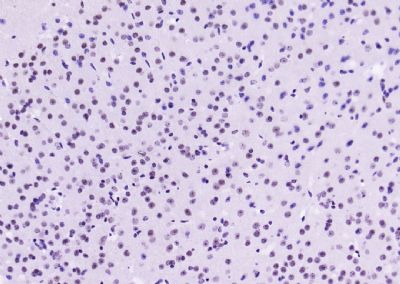 Paraformaldehyde-fixed, paraffin embedded (mouse brain); Antigen retrieval by boiling in sodium citrate buffer (pH6.0) for 15min; Block endogenous peroxidase by 3% hydrogen peroxide for 20 minutes; Blocking buffer (normal goat serum) at 37°C for 30min; Antibody incubation with (phospho-STAT1 (Ser727)) Monoclonal Antibody, Unconjugated (bsm-52209R) at 1:200 overnight at 4°C, followed by operating according to SP Kit(Rabbit) (sp-0023) instructionsand DAB staining.
Paraformaldehyde-fixed, paraffin embedded (mouse spleen); Antigen retrieval by boiling in sodium citrate buffer (pH6.0) for 15min; Block endogenous peroxidase by 3% hydrogen peroxide for 20 minutes; Blocking buffer (normal goat serum) at 37°C for 30min; Antibody incubation with (phospho-STAT1 (Ser727)) Monoclonal Antibody, Unconjugated (bsm-52209R) at 1:200 overnight at 4°C, followed by operating according to SP Kit(Rabbit) (sp-0023) instructionsand DAB staining.
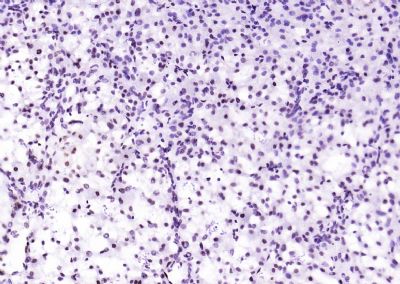 Paraformaldehyde-fixed, paraffin embedded (mouse placenta); Antigen retrieval by boiling in sodium citrate buffer (pH6.0) for 15min; Block endogenous peroxidase by 3% hydrogen peroxide for 20 minutes; Blocking buffer (normal goat serum) at 37°C for 30min; Antibody incubation with (phospho-STAT1 (Ser727)) Monoclonal Antibody, Unconjugated (bsm-52209R) at 1:200 overnight at 4°C, followed by operating according to SP Kit(Rabbit) (sp-0023) instructionsand DAB staining.
Paraformaldehyde-fixed, paraffin embedded (mouse pancreas); Antigen retrieval by boiling in sodium citrate buffer (pH6.0) for 15min; Block endogenous peroxidase by 3% hydrogen peroxide for 20 minutes; Blocking buffer (normal goat serum) at 37°C for 30min; Antibody incubation with (phospho-STAT1 (Ser727)) Monoclonal Antibody, Unconjugated (bsm-52209R) at 1:200 overnight at 4°C, followed by operating according to SP Kit(Rabbit) (sp-0023) instructionsand DAB staining.
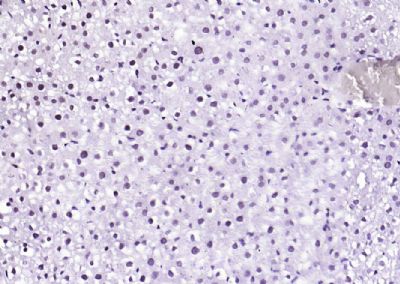 Paraformaldehyde-fixed, paraffin embedded (rat liver); Antigen retrieval by boiling in sodium citrate buffer (pH6.0) for 15min; Block endogenous peroxidase by 3% hydrogen peroxide for 20 minutes; Blocking buffer (normal goat serum) at 37°C for 30min; Antibody incubation with (phospho-STAT1 (Ser727)) Monoclonal Antibody, Unconjugated (bsm-52209R) at 1:200 overnight at 4°C, followed by operating according to SP Kit(Rabbit) (sp-0023) instructionsand DAB staining.
 Paraformaldehyde-fixed, paraffin embedded (rat brain); Antigen retrieval by boiling in sodium citrate buffer (pH6.0) for 15min; Block endogenous peroxidase by 3% hydrogen peroxide for 20 minutes; Blocking buffer (normal goat serum) at 37°C for 30min; Antibody incubation with (phospho-STAT1 (Ser727)) Monoclonal Antibody, Unconjugated (bsm-52209R) at 1:200 overnight at 4°C, followed by operating according to SP Kit(Rabbit) (sp-0023) instructionsand DAB staining.
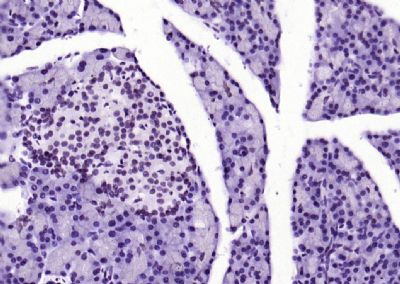 Paraformaldehyde-fixed, paraffin embedded (rat pancreas); Antigen retrieval by boiling in sodium citrate buffer (pH6.0) for 15min; Block endogenous peroxidase by 3% hydrogen peroxide for 20 minutes; Blocking buffer (normal goat serum) at 37°C for 30min; Antibody incubation with (phospho-STAT1 (Ser727)) Monoclonal Antibody, Unconjugated (bsm-52209R) at 1:200 overnight at 4°C, followed by operating according to SP Kit(Rabbit) (sp-0023) instructionsand DAB staining.
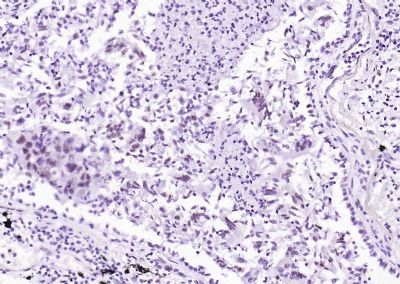 Paraformaldehyde-fixed, paraffin embedded (human lung carcinoma); Antigen retrieval by boiling in sodium citrate buffer (pH6.0) for 15min; Block endogenous peroxidase by 3% hydrogen peroxide for 20 minutes; Blocking buffer (normal goat serum) at 37°C for 30min; Antibody incubation with (phospho-STAT1 (Ser727)) Monoclonal Antibody, Unconjugated (bsm-52209R) at 1:200 overnight at 4°C, followed by operating according to SP Kit(Rabbit) (sp-0023) instructionsand DAB staining.
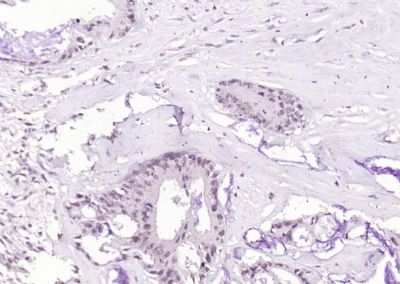 Paraformaldehyde-fixed, paraffin embedded (human cervical carcinoma); Antigen retrieval by boiling in sodium citrate buffer (pH6.0) for 15min; Block endogenous peroxidase by 3% hydrogen peroxide for 20 minutes; Blocking buffer (normal goat serum) at 37°C for 30min; Antibody incubation with (phospho-STAT1 (Ser727)) Monoclonal Antibody, Unconjugated (bsm-52209R) at 1:200 overnight at 4°C, followed by operating according to SP Kit(Rabbit) (sp-0023) instructionsand DAB staining.
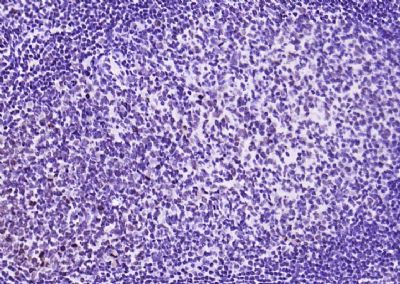 Paraformaldehyde-fixed, paraffin embedded (human tonsil); Antigen retrieval by boiling in sodium citrate buffer (pH6.0) for 15min; Block endogenous peroxidase by 3% hydrogen peroxide for 20 minutes; Blocking buffer (normal goat serum) at 37°C for 30min; Antibody incubation with (phospho-STAT1 (Ser727)) Monoclonal Antibody, Unconjugated (bsm-52209R) at 1:200 overnight at 4°C, followed by operating according to SP Kit(Rabbit) (sp-0023) instructionsand DAB staining.
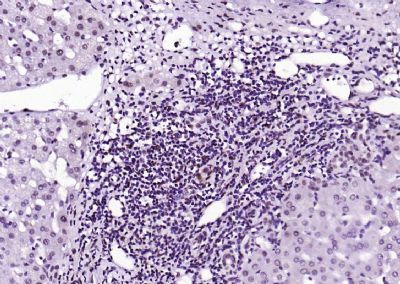 Paraformaldehyde-fixed, paraffin embedded (human liver); Antigen retrieval by boiling in sodium citrate buffer (pH6.0) for 15min; Block endogenous peroxidase by 3% hydrogen peroxide for 20 minutes; Blocking buffer (normal goat serum) at 37°C for 30min; Antibody incubation with (phospho-STAT1 (Ser727)) Monoclonal Antibody, Unconjugated (bsm-52209R) at 1:200 overnight at 4°C, followed by operating according to SP Kit(Rabbit) (sp-0023) instructionsand DAB staining.
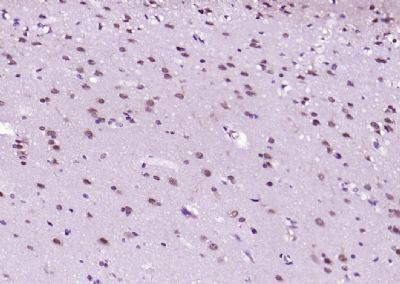 Paraformaldehyde-fixed, paraffin embedded (human brain); Antigen retrieval by boiling in sodium citrate buffer (pH6.0) for 15min; Block endogenous peroxidase by 3% hydrogen peroxide for 20 minutes; Blocking buffer (normal goat serum) at 37°C for 30min; Antibody incubation with (phospho-STAT1 (Ser727)) Monoclonal Antibody, Unconjugated (bsm-52209R) at 1:200 overnight at 4°C, followed by operating according to SP Kit(Rabbit) (sp-0023) instructionsand DAB staining.
|
公司简介

上海雅吉生物科技有限公司成立于2011年3月,是一家面向生命科学领域,科研机构、高校、院所及企业产品开发研究提供所需要的科研类试剂、耗材、仪器、技术服务等。包括分子生物学、免疫学、微生物学、细胞学,通过公司各个部门所有员工的共同努力在行业内拥有较高知名度,深得新老客户的厚爱,本着“优质、服务、信誉”的精神,坚持以先进的技术、优质的产品、良好的信誉,为国内外广大用户提供优质生物产品和服务。公司在重视产品质量的同时,也建立了一套集技术支持、物流、售后服务等多个部门联动服务体系,努力把我们方便、快捷、周到的服务提供给每一个客户本研究所郑重承诺:质量保证、供货及时、服务周到,公司总投资超过2000万元,并先后引进了自动化设备,组建了专业的研发技术团队。凭借着洁净化的生产车间、标准化的质量管理系统,为生产高质量的产品提供了有效保证。
雅吉生物自主研发的ELISA试剂盒,在国内众多重点实验室广泛使用,深受广大科研人员的好评,先后在权威杂志文章中被引用。
上海雅吉生物科技有限公司以极强的职业精神,积极、负责、坦诚的服务令我们的客户满意!
客户服务承诺
以“服务、客户、技术”为根本。客户是我们的核心,坚持以高质量的产品服务客户, 秉持诚信原则,重视客户的意见与感受;我们愿意为大家提供良好的售后服务。希望老师们对我们的服务及工作提出意见,您的满意是我们工作的动力,祝广大师生客户生活工作愉快!
更多产品详情可查询官网:www.yajimall.com
雅吉生物自主研发的ELISA试剂盒,在国内众多重点实验室广泛使用,深受广大科研人员的好评,先后在权威杂志文章中被引用。
上海雅吉生物科技有限公司以极强的职业精神,积极、负责、坦诚的服务令我们的客户满意!
客户服务承诺
以“服务、客户、技术”为根本。客户是我们的核心,坚持以高质量的产品服务客户, 秉持诚信原则,重视客户的意见与感受;我们愿意为大家提供良好的售后服务。希望老师们对我们的服务及工作提出意见,您的满意是我们工作的动力,祝广大师生客户生活工作愉快!
更多产品详情可查询官网:www.yajimall.com
售后服务

试剂盒售后:本公司出售的试剂盒均保质保量,质量问题均可免费退换,另提供免费代测服务。
细胞售后:
1. 细胞运输丢失、瓶身破损、培养液严重漏液等,重发;
3. 细胞收到当天以及第2,3天请拍照,未告知的视为产品合格。4-10天内出现问题,请提供细胞照片和细胞出现问题的照片以及细胞相关操作的详细步骤,并跟我公司人员及时沟通判定是否重发,具体可以参照我官网或者随货说明书相关售后条款。
相关视频

暂无
资料下载

暂无
联系方式

| 单位名称: |
|
详细地址:
上海市闵行区元江路5500号第1幢5658室
|
|
qq:
58268971
|
| 联系电话: |
| Email: |



